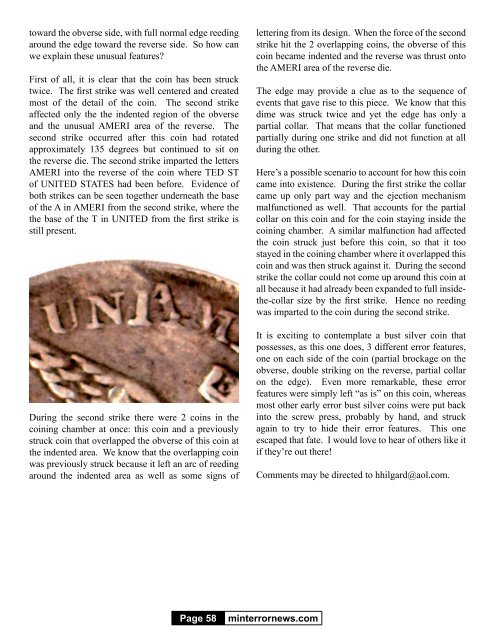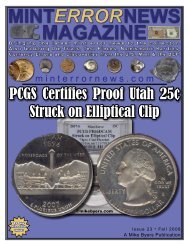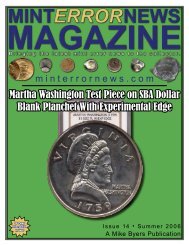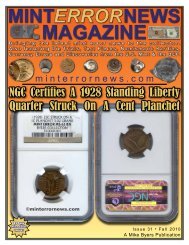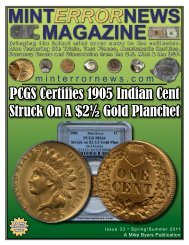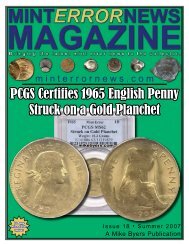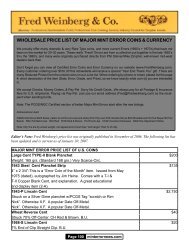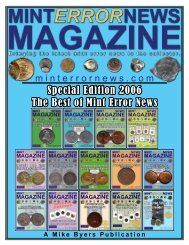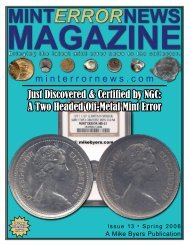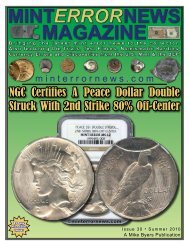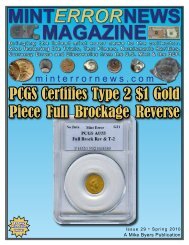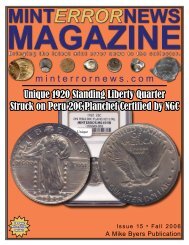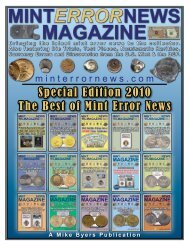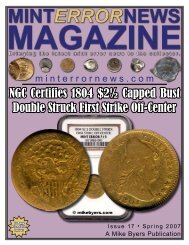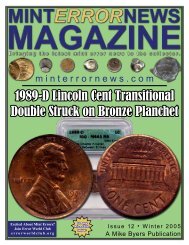Create successful ePaper yourself
Turn your PDF publications into a flip-book with our unique Google optimized e-Paper software.
toward the obverse side, with full normal edge reeding<br />
around the edge toward the reverse side. So how can<br />
we explain these unusual features?<br />
First of all, it is clear that the coin has been struck<br />
twice. The first strike was well centered and created<br />
most of the detail of the coin. The second strike<br />
affected only the the indented region of the obverse<br />
and the unusual AMERI area of the reverse. The<br />
second strike occurred after this coin had rotated<br />
approximately 135 degrees but continued to sit on<br />
the reverse die. The second strike imparted the letters<br />
AMERI into the reverse of the coin where TED ST<br />
of UNITED STATES had been before. Evidence of<br />
both strikes can be seen together underneath the base<br />
of the A in AMERI from the second strike, where the<br />
the base of the T in UNITED from the first strike is<br />
still present.<br />
During the second strike there were 2 coins in the<br />
coining chamber at once: this coin and a previously<br />
struck coin that overlapped the obverse of this coin at<br />
the indented area. We know that the overlapping coin<br />
was previously struck because it left an arc of reeding<br />
around the indented area as well as some signs of<br />
lettering from its design. When the force of the second<br />
strike hit the 2 overlapping coins, the obverse of this<br />
coin became indented and the reverse was thrust onto<br />
the AMERI area of the reverse die.<br />
The edge may provide a clue as to the sequence of<br />
events that gave rise to this piece. We know that this<br />
dime was struck twice and yet the edge has only a<br />
partial collar. That means that the collar functioned<br />
partially during one strike and did not function at all<br />
during the other.<br />
Here’s a possible scenario to account for how this coin<br />
came into existence. During the first strike the collar<br />
came up only part way and the ejection mechanism<br />
malfunctioned as well. That accounts for the partial<br />
collar on this coin and for the coin staying inside the<br />
coining chamber. A similar malfunction had affected<br />
the coin struck just before this coin, so that it too<br />
stayed in the coining chamber where it overlapped this<br />
coin and was then struck against it. During the second<br />
strike the collar could not come up around this coin at<br />
all because it had already been expanded to full insidethe-collar<br />
size by the first strike. Hence no reeding<br />
was imparted to the coin during the second strike.<br />
It is exciting to contemplate a bust silver coin that<br />
possesses, as this one does, 3 different error features,<br />
one on each side of the coin (partial brockage on the<br />
obverse, double striking on the reverse, partial collar<br />
on the edge). Even more remarkable, these error<br />
features were simply left “as is” on this coin, whereas<br />
most other early error bust silver coins were put back<br />
into the screw press, probably by hand, and struck<br />
again to try to hide their error features. This one<br />
escaped that fate. I would love to hear of others like it<br />
if they’re out there!<br />
Comments may be directed to hhilgard@aol.com.<br />
Page 58<br />
minterrornews.com


